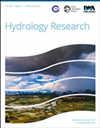气候变化和土地覆盖变化情景下的未来径流评估:以Zayandeh-Roud大坝上游流域为例
IF 2.4
4区 环境科学与生态学
Q2 Environmental Science
引用次数: 2
摘要
在本研究中,评估了Zayandeh-Roud大坝上游流域对气候变化和土地覆盖变化对未来径流的水文响应。在这方面,使用陆地卫星时间序列(TM和OLI)、支持向量机(SVM)和CA马尔可夫链模型生成了1996年、2008年、2018年和2033年的土地利用图,用于分析土地覆盖变化对未来径流的影响。其次,对RCP 2.6和RCP 8.5情景下的全球环流模型情景时间序列进行了缩减,以评估气候变化对未来流量的影响。最终,HEC-HMS模型被校准(1996-2018),用于评估气候和土地利用地图变化的影响。结果显示,与2018年相比,2033年Eskandari站上游的城市面积和农田比例预计将分别增长0.1和2.39%,Ghale Shahrokh站上游的城镇面积和农田百分比预计将分别增加0.05和0.71%,尽管这两个地区的贫瘠面积比例预计几乎保持不变。预计2033年Eskandari和Ghale Shahrokh站的未来流量将分别减少570-630亿立方米(RCP 2.6和RCP 8.5)和295-403亿立方米,其中在气候变化情景下,预计将减少68-72%和79-86%,剩余流量是由于土地覆盖变化。本文章由计算机程序翻译,如有差异,请以英文原文为准。
Future runoff assessment under climate change and land-cover alteration scenarios: a case study of the Zayandeh-Roud dam upstream watershed
In this study, hydrological responses to climate change and land-cover alteration on future runoff in the Zayandeh-Roud dam upstream watershed were assessed. In this regard, land-use maps in 1996, 2008, 2018, and 2033 were generated using Landsat time-series (TM and OLI), Support-Vector Machine (SVM), and the CA-Markov chain model, for analysing the effects of land-cover alteration on future runoff. Second, the Global Circulation Model (GCM) scenario time-series under RCP 2.6 and RCP 8.5 scenarios were downscaled to evaluate the impacts of climate change on future streamflow. Eventually, the HEC-HMS model was calibrated (1996–2018) for evaluating the impacts of climate and land-use map changes. Results showed that the percentage of the urban area and farmland in 2033 compared to 2018 were expected to grow by 0.1 and 2.39% upstream of the Eskandari station and 0.05 and 0.71% upstream of the Ghale-Shahrokh station, respectively, although the percentage of the barren area was expected to remain almost unchanged in both regions. The future stream flow of Eskandari and Ghale-Shahrokh stations in 2033 was expected to decrease by 57–63 MCM (for RCP 2.6 and RCP 8.5) and 295–403 MCM, respectively, where 68–72% and 79–86% were expected to decrease under climate change scenarios and remains are due to land-cover alteration.
求助全文
通过发布文献求助,成功后即可免费获取论文全文。
去求助
来源期刊

Hydrology Research
Environmental Science-Water Science and Technology
CiteScore
5.30
自引率
7.40%
发文量
70
审稿时长
17 weeks
期刊介绍:
Hydrology Research provides international coverage on all aspects of hydrology in its widest sense, and welcomes the submission of papers from across the subject. While emphasis is placed on studies of the hydrological cycle, the Journal also covers the physics and chemistry of water. Hydrology Research is intended to be a link between basic hydrological research and the practical application of scientific results within the broad field of water management.
 求助内容:
求助内容: 应助结果提醒方式:
应助结果提醒方式:


